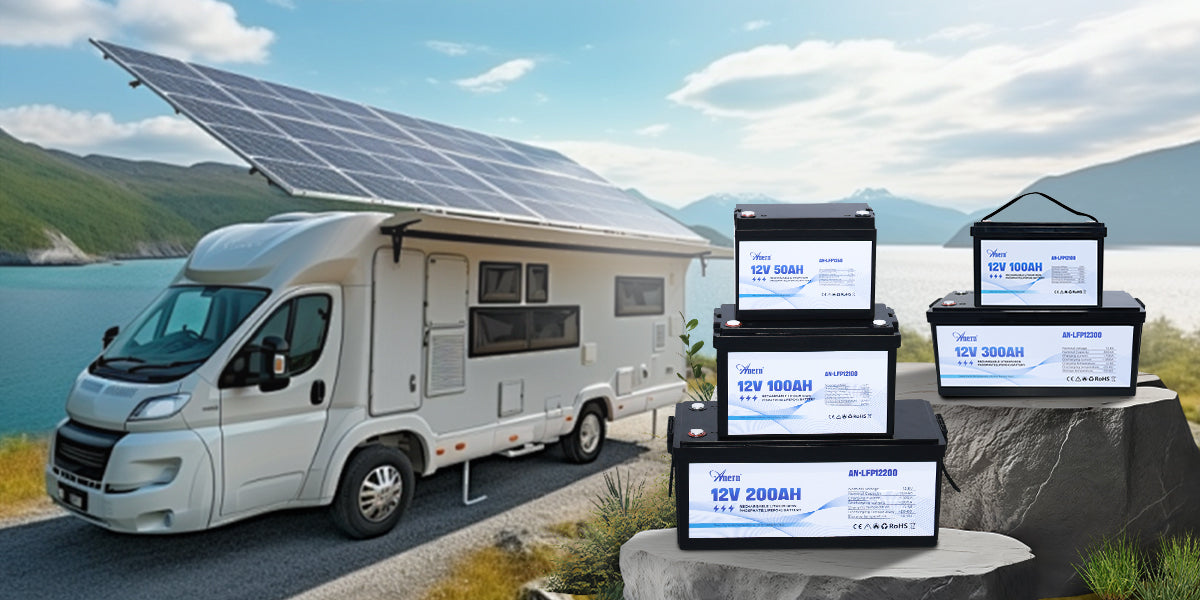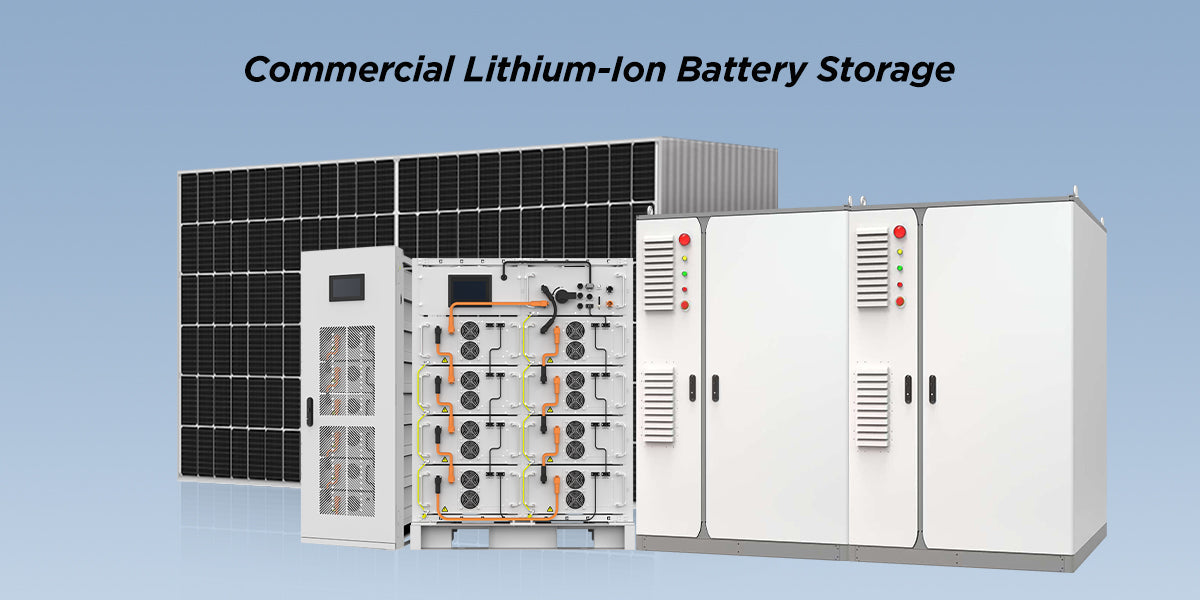Owners want quiet power that lasts through real trips, not only spec sheets. This guide shows a simple way to size your system, compare chemistries, and check compatibility, so your next lithium battery upgrade feels confident from day one. You will see how to translate daily loads into amp-hours, how voltage choices change cabling and inverter performance, and how charging profiles keep a pack healthy through shore power, alternator, and solar.
How Big Should Your RV Lithium Battery Be?
Getting the size right starts with a one-day load audit, then turns those watt-hours into amp-hours you can shop against.
Quick worksheet
| Device | Watts | Hours per day | Daily Wh |
| 12 V fridge | 60 | 10 | 600 |
| LED lights | 20 | 5 | 100 |
| Water pump | 60 | 0.5 | 30 |
| Fan | 25 | 4 | 100 |
| Laptop | 60 | 2 | 120 |
| Total | 950 |
Now add a comfort reserve, for example, 25 percent.
Daily need becomes about 1,187 Wh. For a 12 V system, the required usable capacity is roughly 99 Ah, since Ah equals Wh divided by system voltage. With a typical usable depth around 80 percent, a rated pack near 125 Ah covers this profile. This approach scales. If you double your loads, move to 250 Ah or adjust to 24 V so the current stays manageable. That is the core logic behind sizing an RV lithium battery without guesswork.
12V, 24V, or 48V: Which System Voltage Fits RVs and Boats?
Voltage sets the current through your cables, and current dictates wire size, losses, and heat. A 12 V lithium battery suits small to mid setups where most loads already run on 12 V. Step to 24 V when inverters reach past two to three kilowatts or cable runs grow long. Consider 48 V for larger house banks that serve air conditioning, induction cooking, or heavy winches. Matching the voltage across the inverter, charger, and solar controller simplifies setup, reduces adapters, and improves overall efficiency.
LiFePO4 vs Other Lithium: Which Chemistry Is Safest for RVs and Boats?
Chemistry shapes safety, cycle life, and voltage stability. A lithium battery built with LiFePO4 cells offers a calm thermal profile and a flat discharge curve that keeps inverters happier at higher loads. That means lights stay bright and compressors start more consistently deep into a cycle. A well-designed pack adds a battery management system with protection for over-charge, over-discharge, over-current, and temperature. Cold-charge protection matters in shoulder seasons and at altitude, so confirm that feature if you camp or anchor in cool climates.
Upgrading RV to Lithium Battery: What Changes Matter?
Moving from lead to lithium changes how charging, wiring, and protection should look. Use a charger or inverter-charger with a user profile for lithium-ion battery settings. Set absorption and float per the data sheet, and disable equalization if it cannot be tailored. Review the main fuse size and location near the positive terminal, confirm cable gauge for the higher continuous current that a healthy pack can supply, and add a main disconnect within reach. If solar is on board, confirm the MPPT controller allows custom voltage points for LiFePO4.
Do You Need a DC-DC Charger From the Alternator and Why?
Alternators expect batteries that naturally limit current. A strong lithium battery can accept far more, which can overheat a stock alternator during long bulk charging. A DC-DC unit limits current to a safe value, applies the correct lithium profile, and stabilizes charging in vehicles or boats with smart alternators that vary output for fuel savings. You can skip a DC-DC device when alternator charging is truly occasional and current is limited by design, yet most full-time travelers value the protection and predictable charging it provides.
Best Lithium Battery for Trolling Motor: 12V, 24V, 36V, and How Many Ah?
Trolling motors publish a rated voltage and a current draw that changes with speed and conditions. Runtime in hours is roughly usable amp-hours divided by the current at your typical throttle setting. For example, a 100 Ah pack with about 80 Ah usable, paired with a cruise draw near 30 A, yields a little over three hours of steady movement. Heavier hulls, headwinds, or weed beds raise current, which suggests a larger bank. Choose the pack voltage to match the motor, then place the bank close to the load to keep cables short.
What Charging Profile Should a 12V Lithium Battery Use on Shore Power and Solar?
Healthy packs come from correct setpoints. Follow the data sheet for absorption voltage and duration, choose a conservative float, and turn off equalize unless the manufacturer permits a very low equalize value for pack balancing. Keep the charge rate within the recommended C rate. Temperature compensation works differently for LiFePO4 compared with flooded batteries, so confirm the solar controller behavior. When sources mix, for example a generator and solar, let the highest priority device manage the profile, with others set as supportive or limited.
Cold-Weather Rules for a Lithium Battery on RVs and Boats
Low temperatures change how any pack should be treated. Charging at or below the freezing point risks plating that shortens life. Packs with internal heat help, yet smart placement in a conditioned space reduces the need to rely on heaters. During storage, keep a moderate state of charge, disconnect parasitic loads, and check the bank periodically. For boaters, consider condensation control around the compartment.

Building Your Battery Bank: Series vs Parallel and Protection
Series raises voltage, parallel raises capacity. Keep models and age-matched within a bank, and use equal-length cables to parallel blocks. Solid busbars help current share. Protect each branch with a fuse or breaker sized for the cable, then protect the main feed near the bank. Add a shunt-based battery monitor so hours of runtime translate into a clear state off charge. Communication lines such as Bluetooth, CAN, or RS485 allow an inverter or charger to follow the pack’s request for current and voltage, which improves performance under heavy loads.
Install and Safety Checklist for RVs and Boats
Small installation choices decide daily reliability. Review this short list during planning and again before the first power-up.
- Place the main fuse within inches of the positive post, secure the main disconnect, and label both sides.
- Size cables for continuous current with a margin, support long runs every few inches, and add chafe protection through bulkheads.
- Keep connections clean and tight, use proper lugs and a quality crimp tool, and route cables away from heat sources.
- Verify ventilation for chargers and inverters, and select enclosures with appropriate ingress protection in damp lockers.
- Add strain relief near heavy components and include a drip loop where water exposure is possible.
Pick a Right-Sized Lithium Battery and Make RV or Boat Power Simple
Clear steps remove guesswork. Start with a one-day load number in watt-hours, convert to amp-hours at your chosen system voltage, and pick a capacity that meets your target with a reserve for poor weather and headwinds. Choose LiFePO4 when safety, cycle life, and steady voltage under load matter for comfort on the road or on the water. Confirm charging profiles on shore power and solar, add a DC-DC charger when alternator use is meaningful, and tidy the bank with correct fusing, cable gauge, and monitoring.
FAQs
Q1. Can I keep my lead-acid starter battery with a lithium house bank?
Yes. Keep starter and house banks isolated and charge the lithium bank through a DC to DC charger sized to your alternator. Add an emergency parallel switch with proper fusing and keep each bank on its own profile to protect alternator health and cranking.
Q2. Do lithium batteries in RVs or boats need ventilation?
LiFePO4 packs are sealed and do not vent during normal use. Provide space for heat dissipation and airflow for chargers and inverters. Avoid engine compartment hot spots and splash zones. Choose an enclosure with suitable ingress protection and secure the pack against vibration.
Q3. How do I pass insurance or marine survey checks after conversion?
Document wiring to ABYC E-11 and lithium integration to E-13, list device ratings, and label shutoffs. Photograph the main fuse near the battery, cable gauges, and strain relief. Keep manuals, certifications, and the UN38.3 test summary. Some insurers may require inspection or an endorsement.
Q4. Can I ship or carry a large lithium battery for a refit?
Installed packs travel by road or ferry without special steps. Air shipment of high-capacity batteries is restricted. For freight, request the UN38.3 summary, use approved packaging, cover terminals, ship near 30 percent state of charge, and book a hazmat-capable carrier.
Q5. What should I plan for the end of life and recycling?
Contact the manufacturer or an e-waste recycler that accepts lithium iron phosphate packs. Many offer take-back programs. If capacity remains useful, consider a second life in a low-current, stationary role. Reset Bluetooth modules to protect data, and never dispose of cells in trash.




Leave a comment
All comments are moderated before being published.
This site is protected by hCaptcha and the hCaptcha Privacy Policy and Terms of Service apply.